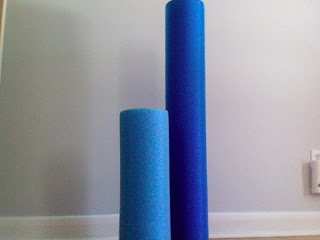Foam Roller for Injury Prevention
If you haven't heard of a foam roller you are definitely missing out! A foam roller is a runners best friend and can help get you to the end of a training season, speedy, loose and injury free! A foam roller can be used pre or post run (or anytime between runs) to roll out tight muscles. The process is simple, choose the area of the body you are looking to lengthen or massage, lay that body segment perpendicular to the foam roller and by lifting the rest of your body up off the ground and pushing yourself over the foam roller while maintaining contact with the body part you are looing to work on the foam roller, you can roll back and forth slowly while covering a small portion of that muscle or structure you are trying to work. Sound confusing? It's really not. Let's try an example... your right "IT" or iliotibial band (outside or your thigh) is tight 1. Place the foam roller on the floor 2. Lay the right side of your thigh on top of the foam roller so you and the foam roller are at 90 degree angles from one another. 3. While keeping your thigh in conact with the foam roller use your hands to walk your body forward and back along the foam roller but only roll down to above your knee joint (without crossing the knee) and up to just below your outside hip bone. Suggested "roll time" would be 1 minute per side...then switch to the left and give it a try!
Foam rollering can often be painful, especially along the IT band, so feel free to de-weight part of the pressure on the foam roller by planting your other foot on the ground and taking a portion of your body weight off of the foam roller.
Here is a list of possible areas to try on the foam roller:
IT band (side of upper thigh)
Quadriceps (anterior thigh)
Hamstrings (back thigh)
Calves (back of lower leg)
Hip flexors (front hip)
Lower back
Mid back
Glutes and piriformis (bum muscles)
***now of course foam rollering is no substitute for accurate diagnosis and medical treatment by a health care profession like a physiotherapist or a doctor, so if you are unsure of what the problem truly is and you think it may be more serious then a sore or tight muscle please make sure to seek help from a professional! I am always open to an email or message with questions!
www.youtube.com is a great place to check out videos of foam rolling techniques and tips. Cost wise a foam roller usually runs $30-$80 depending on the density, durability and length. The denser (and typically darker) in colour the foam roller the more pressure it applies so choose wisely!
Happy foam rolling!

